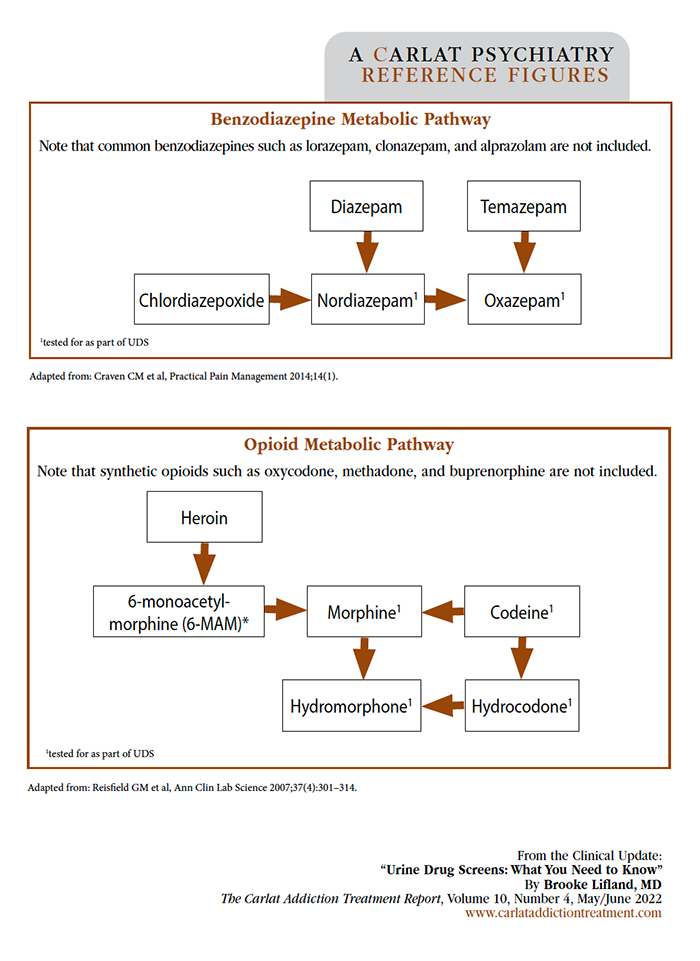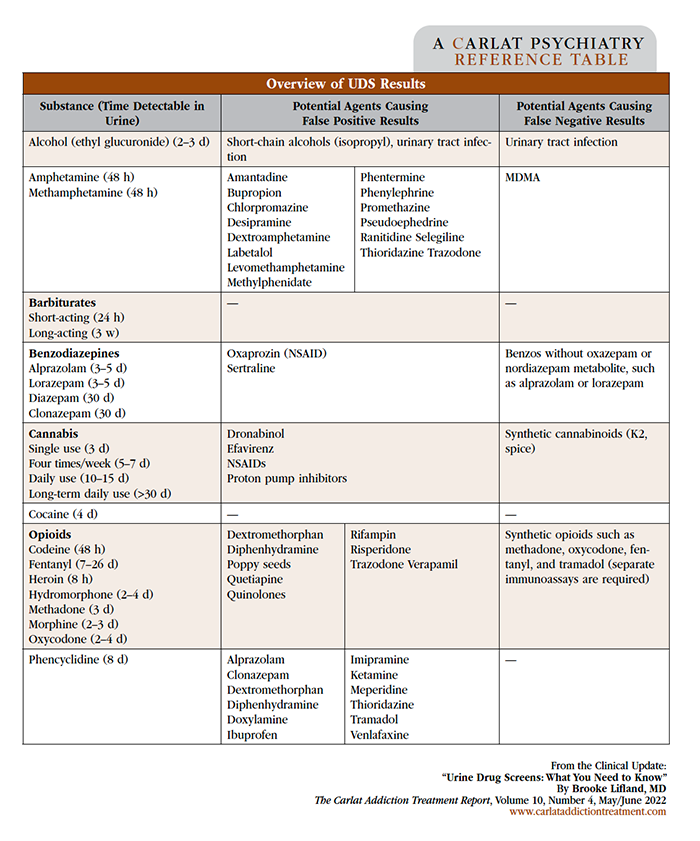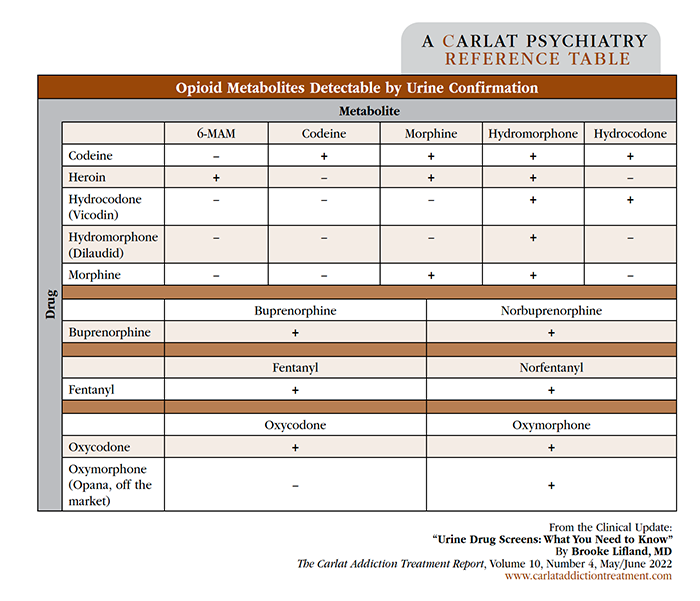Urine Drug Screens: What You Need to Know
Brooke Lifland, MD. Resident in psychiatry, Yale University. New Haven, CT. Dr. Lifland has disclosed no relevant financial or other interests in any commercial companies pertaining to this educational activity.
What should you do with unexpected urine toxicology results? When should you suspect a false test? What is confirmatory testing? In this article, we’ll answer these questions and more, giving you everything you need to know about urine toxicology testing in the clinical setting.
The tests: Screening and confirmation
There are two types of urine toxicology testing—presumptive testing, commonly called a urine drug screen (UDS), and confirmatory testing, which is used to verify UDS results. Both tests detect metabolites excreted into the urine after substance use.
UDS uses a technology called immunoassay, which relies on antibody binding (Melanson SEF, Clin Lab Med 2012;32(3):429–447). It’s quick (a day or two at an outside laboratory or a few hours in house) and inexpensive (<$30), but can be prone to false results.
Confirmatory testing, though highly accurate, is slower (72 hours or more) and more expensive (up to $250); therefore it is reserved for verifying questionable UDS results. It works by volatilizing metabolites, then using gas chromatography–mass spectrometry to determine their chemical composition (Wu A et al, Clin Toxicol (Phila) 2012;50(8):733–742). Some laboratories automatically do confirmatory testing on all positive UDS results (a practice known as reflex testing), while others don’t. If you want a negative result confirmed to ensure that a patient is taking something you prescribed, you will almost always need to order the confirmatory test separately. Keep in mind that labs discard urine samples after a set time, so familiarize yourself with institutional protocols and be aware of how long you have to order confirmatory testing.
Timing is everything
The results of a urine test depend substantially on its timing. Some substances (cocaine, short-acting opioids) create metabolites that are only excreted for a short amount of time, while others (cannabis, fentanyl) create metabolites that are detectable for as long as a month. Metabolites can be found in urine for varying lengths of time based on a host of factors: individual metabolism, fat solubility, short-acting vs long-acting formulations, frequency of use, and comorbidities such as kidney or liver disease. The times listed in the “Overview of UDS Results” table can be useful when interpreting UDS results and deciding whether to order confirmatory testing. For example, a patient could have a positive UDS for cannabis even after abstaining from use for a month, whereas that is not the case for a substance like cocaine.
Table: Overview of UDS Results
(Click to view full-sized PDF.)
Urine drug screen results
Immunoassay results are reported as “positive” or “negative” based on a predetermined cutoff. Sensitivity and specificity values vary according to the drug being detected and the test manufacturer, but they are generally reliable. Unfortunately, UDS results can occasionally present problems.
False positives
False positives occur when antibodies meant to bind to a specific drug metabolite cross-react with another similarly structured molecule. Some immunoassays are more prone to false positives than others. The table presents a fairly comprehensive list of common false positives.
False negatives
False negatives occur for several reasons. Sometimes, the UDS itself is not designed to detect the metabolites of the substance you are looking for. Benzodiazepines are a well-known example. UDS detects nordiazepam and/or oxazepam, which are metabolites of some but not all benzodiazepines (see “Benzodiazepine Metabolic Pathway” figure). If your patient is taking alprazolam, lorazepam, or clonazepam, which do not produce these metabolites, the immunoassay can show a false negative benzodiazepine result. Of course, these are some of the most commonly misused benzodiazepines. In such a situation, you can order confirmatory testing that looks for metabolites of these drugs.
False negatives can also result when a patient is using opioids. UDS reliably detects metabolites of naturally derived opiates such as morphine, codeine, and heroin. Semi-synthetic and synthetic opioids (such as buprenorphine, methadone, hydrocodone, oxycodone, tramadol, and fentanyl) bind erratically and only sometimes result in a positive test. Therefore, if your institution does not have an automatic UDS for semi-synthetic and synthetic opioids, you will need to order individual screens for them (Milone MC, J Med Toxicol 2012; 8(4):408–416). See “Opioid Metabolic Pathway” figure.
 Figures: Metabolic Pathway Figures
Figures: Metabolic Pathway Figures
(Click to view full-sized PDF.)
Lastly, improper antibody binding can result in a false negative, which can happen if a patient intentionally adulterates their urine sample. Several commercially available adulterants and household products can be used to produce negative results. If you are suspicious, consider direct observation and order a urinalysis along with the UDS. Specific gravity or pH values outside the normal range can suggest that a sample has been tampered with. Some labs test to determine whether a sample is valid by looking for the presence of bleach, glutaraldehyde, and chlorochromates (which are not normally present) as well as creatinine, nitrites, and uric acid (which should be present but are often absent from faked samples). Keep in mind that even direct observation and lab results can be circumvented if the patient substitutes fake urine and uses a prosthesis such as the “Whizzinator.” A quick temperature check can uncover at least some of these attempts at deception.
Confirmatory testing
Confirmatory testing is reported differently than a qualitative UDS report. Rather than reporting a positive or negative, confirmatory testing reports the presence and concentration of individual metabolites. Although these reports contain a lot of potentially useful information, they can be challenging to interpret and require knowledge of relevant metabolic pathways.
Table: Opioid Metabolites Detectable by Urine Confirmation
(Click to view full-sized PDF.)
For example, a confirmatory test for diazepam would show the presence of nordiazepam and oxazepam, whereas a confirmatory test for temazepam would only report the presence of oxazepam (refer to the “Benzodiazepine Metabolic Pathway” figure). The confirmatory test for a patient taking oxazepam would, likewise, only show oxazepam. Benzodiazepines outside of this pathway, such as clonazepam or alprazolam, have their own metabolites to test for. When examining the test results, look for a key that tells you which metabolites correspond to which substances. When in doubt, call the laboratory for clarification. See the interview with Dr. Becker in this issue for another example of using metabolic pathways to interpret confirmatory testing, this time with opioids.
In general, unlike electrolyte or cell count values, the concentration of a metabolite at a single point in time is not particularly useful. Trending values over time, however, can help determine whether a patient has returned to use. Metabolite concentrations that consistently fall from one appointment to another can indicate that the patient is abstaining. Conversely, a large spike in metabolite concentration suggests recent use. While useful, trending isn’t bulletproof; dehydration and P450 inhibition can lead to higher-than-expected levels, giving a false impression of increased or sustained use (Kapur B and Aleksa K, Crit Rev Clin Lab Sci 2020;57(8):548–585).
CARLAT VERDICT
UDS deserves its role as a clinic workhorse but can be prone to false positives and negatives. If you encounter an unexpected positive result, look for agents known to cause false positives. If you encounter an unexpected negative result, double-check that the assay tests for the substance you are looking for, clarify the timeline, and consider the possibility of sample tampering. If doubt remains, order confirmatory testing.
Newsletters
Please see our Terms and Conditions, Privacy Policy, Subscription Agreement, Use of Cookies, and Hardware/Software Requirements to view our website.
© 2025 Carlat Publishing, LLC and Affiliates, All Rights Reserved.




_-The-Breakthrough-Antipsychotic-That-Could-Change-Everything.webp?t=1729528747)



